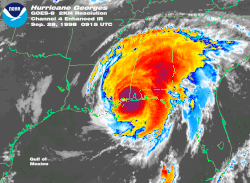
A Mississippi hurricane is a North Atlantic tropical cyclone that affected the U.S. state of Mississippi. From 1851 to the present, 108 tropical cyclones have passed through Mississippi. The costliest and deadliest hurricane in this period was Hurricane Katrina in 2005. Six hurricanes have made landfall as major hurricanes, [nb 1] the strongest of them being Hurricane Camille in 1969.
Contents
- Storms
- Pre-1900
- 1900s
- 2000s
- Listed by month
- Major hurricanes
- Deadly storms
- See also
- Notes
- References

